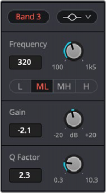
< Previous | Contents | Next >
— Band filter type: Bands 1 and 6 can be switched among four specific filtering options for processing the lowest or highest frequencies in the signal. These include (from top to bottom): Low Shelf, Low Peak, High Shelf, High Pass for Band 1, and Low Pass, Low Shelf, High Peak, High Shelf for Band 6.
— Frequency: Adjusts the center frequency of the EQ adjustment
— Gain: Adjusts gain in dB, with a range of ±20 dB. Only available when bands are set to a peaking or shelving response curve.
Bands 2–5

The middle four sets of band controls let you make a wide variety of equalization adjustments. They’re on by default to make it easy to begin making adjustments.
Band 3 controls
— Band enable button: Clicking the band name turns each EQ band on and off.
— Band filter type: Bands 2–5 can be switched among four different filtering options (from top to bottom), Low Shelf, Peaking, Notch, and High Shelf.
— Frequency: Adjusts the center frequency of the EQ adjustment.
— L, ML, MH, H Buttons: Sets the EQ frequency to predetermined frequency ranges per band with Low, Medium Low, Medium High, and High settings.
— Gain: Adjusts gain in dB, with a range of ±20 dB. Only available when bands are set to a peaking or shelving response curve.
— Q Factor: Adjusts Q (bandwidth). Range of .3 to 10.3. Smaller numbers reflect wider bandwidth and higher numbers are narrower bandwidth. Q is only available when a band is set to a peaking response, or on the Fire Type for shelving, and will control the overall shape of the boost or cut. The Equalizer Types choices in the drop-down menu alter the Q to emulate the chosen console type.